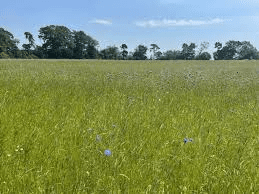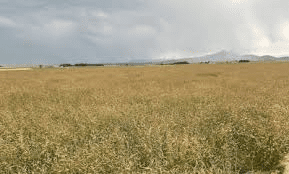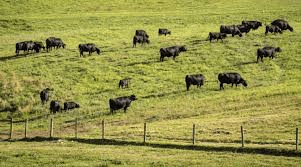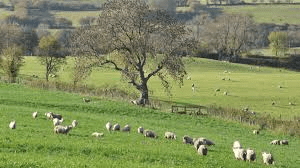Grassland management involves the sustainable use and preservation of grassland ecosystems. Grasslands are essential parts of our environment, supporting diverse wildlife and providing resources for agriculture.
Managing these areas effectively ensures their health and productivity while also benefiting the community and ecosystem. This article will guide you through the importance of grasslands, their types, ecological understanding, and key principles for effective management.
Importance of Grasslands
Grasslands are valuable ecosystems that offer a range of benefits:
1. Biodiversity: Grasslands host a variety of plant and animal species. This biodiversity is crucial for ecological balance. For example, native grasses provide habitat for insects, birds, and small mammals.
2. Livestock Grazing: Many farmers rely on grasslands for grazing livestock, such as cattle and sheep. Healthy grasslands produce nutritious forage, supporting animal health and agricultural productivity.
3. Soil Health: Grasslands play a vital role in maintaining soil health. The roots of grasses help prevent erosion and improve soil structure. Healthy soils contribute to water retention and nutrient cycling.
4. Carbon Sequestration: Grasslands can capture and store carbon dioxide from the atmosphere, helping to mitigate climate change. This process involves plants using carbon for growth, which reduces greenhouse gases.
5. Water Regulation: Grasslands act as natural water filters. They absorb rainfall, reduce runoff, and recharge groundwater supplies. This regulation helps maintain water quality and availability.
Read Also: Gray Leaf Spot (Stemphylium spp) – Symptoms and Damage Control
Types of Grasslands

Understanding the different types of grasslands is crucial for effective management. Here are the main categories:
1. Temperate Grasslands: Found in regions with hot summers and cold winters, these grasslands are characterized by their rich soil and extensive grasses. Examples include the prairies of North America and the steppes of Eurasia.
2. Tropical Grasslands (Savannas): These grasslands are located near the equator and have a warm climate. They are known for their mixed vegetation of grasses and scattered trees. The African savanna is a well-known example.
3. Floodplain Grasslands: Located near rivers and streams, these grasslands experience seasonal flooding. They support unique plant species adapted to wet conditions, such as sedges and rushes.
4. Coastal Grasslands: Found along coastlines, these grasslands are shaped by saltwater and wind. They often feature salt-tolerant grasses and provide habitat for migratory birds.
5. Montane Grasslands: These grasslands are located at higher elevations, often above the tree line. They are characterized by hardy grasses and diverse wildflowers. Examples can be found in the Rocky Mountains.
Understanding Grassland Ecology
To manage grasslands effectively, it’s important to understand their ecology. This includes the interactions between plants, animals, and their environment.
1. Plant Adaptations: Grasses have unique adaptations that allow them to thrive in grassland environments. Their deep root systems help them access water and nutrients, while their ability to grow back after grazing or fire makes them resilient.
2. Animal Interactions: Many animals depend on grasslands for food and shelter. Herbivores like bison and antelope graze on grasses, while predators like hawks and foxes rely on these animals for sustenance. This balance is essential for maintaining healthy ecosystems.
3. Nutrient Cycling: Nutrients are recycled within grassland ecosystems through the decomposition of plant material and animal waste. Healthy soil supports the growth of grasses, which in turn provide food for animals.
4. Fire Ecology: Fire is a natural part of many grassland ecosystems. Controlled burns can help manage grasslands by removing old growth, allowing new grasses to sprout. This process also stimulates flowering in some species.
5. Seasonal Changes: Grasslands experience seasonal variations that affect plant growth and animal behavior. Understanding these changes is vital for timing management practices, such as grazing and mowing.
Key Principles of Grassland Management
Effective grassland management relies on key principles that guide actions and decisions. Here are some essential principles:
1. Sustainability: Management practices should be sustainable, ensuring that grasslands remain productive over the long term. This means balancing the needs of agriculture, wildlife, and the environment.
2. Adaptive Management: Flexibility is key in grassland management. Land managers should be prepared to adjust practices based on monitoring and changing conditions. For example, if invasive species emerge, management strategies may need to shift.
3. Biodiversity Enhancement: Promoting biodiversity is crucial for healthy ecosystems. Managers should encourage the growth of native plant species and create habitats for various wildlife. This can involve planting diverse grass species and minimizing monocultures.
4. Soil Health Focus: Maintaining soil health is a priority. This involves practices such as reducing tillage, adding organic matter, and preventing erosion. Healthy soils support strong grass growth and improve resilience against drought.
5. Community Engagement: Involving local communities in grassland management fosters stewardship and cooperation. Educating the public about the importance of grasslands can lead to better support for conservation efforts.
Read Also: Recommended Number of Ruminant Animals per Housing Unit for Fattening
Step-by-Step Guide to Grassland Management

For those new to grassland management, following a step-by-step approach can be helpful:
1. Assess the Land: Begin by evaluating the grassland area. Check for soil health, plant diversity, and any signs of degradation or invasive species.
2. Set Objectives: Define clear management goals. Do you want to improve livestock grazing, enhance biodiversity, or restore a degraded area? Having specific objectives will guide your actions.
3. Develop a Management Plan: Create a plan outlining the steps needed to achieve your objectives. Include details such as grazing schedules, planting native species, and monitoring practices.
4. Implement Practices: Carry out the planned management practices. This may involve seeding, controlled burns, or implementing grazing rotations. Ensure that you follow best practices for each activity.
5. Monitor Progress: Regularly assess the health of the grassland. Monitor plant growth, soil quality, and wildlife presence. This data will help you evaluate the effectiveness of your management strategies.
6. Adjust as Needed: Be prepared to modify your management practices based on monitoring results. If certain approaches aren’t working, don’t hesitate to try new techniques or consult with experts.
7. Educate and Engage: Share knowledge with the community and involve them in management efforts. Hosting workshops or field days can raise awareness and encourage local participation.
Soil Health and Grassland Productivity
Soil health is fundamental to grassland productivity. Healthy soil supports robust plant growth, which in turn sustains livestock and wildlife. Here are some important factors regarding soil health in grasslands:
1. Nutrient Availability: Healthy soil contains essential nutrients like nitrogen, phosphorus, and potassium. These nutrients are critical for grass growth. Testing soil regularly helps determine nutrient levels and informs fertilization needs.
2. Organic Matter: Adding organic matter, such as compost or manure, improves soil structure, increases moisture retention, and supports beneficial microorganisms. Healthy soil with adequate organic matter fosters strong grass growth.
3. Soil Structure: Well-structured soil allows for better root penetration and water infiltration. Practices like reduced tillage and cover cropping can enhance soil structure, promoting grassland productivity.
4. Erosion Prevention: Grass roots hold soil in place, preventing erosion. Managing grazing and avoiding overgrazing are crucial to maintaining healthy soil and preventing degradation.
5. pH Balance: The soil’s pH affects nutrient availability. Most grasses thrive in slightly acidic to neutral pH levels (6.0 to 7.0). Regular testing and amendments can help maintain proper pH levels for optimal grass growth.
Grazing Management Techniques

Grazing management is vital for maintaining healthy grasslands and maximizing productivity. Here are some effective techniques:
1. Rotational Grazing: This involves moving livestock between different pasture areas to prevent overgrazing. Grazing one area allows grass to recover, promoting healthier plants and soil.
2. Stocking Rate Management: Determine the appropriate number of animals for a given pasture size. Overstocking can lead to overgrazing and soil compaction, while understocking can result in underutilized resources.
3. Timing of Grazing: Grazing at the right time is essential for grass recovery. Allowing grasses to grow to a certain height before grazing ensures they can regenerate effectively.
4. Rest Periods: Providing rest periods for grazed areas allows plants to recover and grow back stronger. The length of rest periods depends on factors like grass species and seasonal growth patterns.
5. Monitoring Animal Health: Healthy animals contribute to productive grazing systems. Regular veterinary checks and proper nutrition ensure livestock are in good condition, which can lead to better grazing management.
Weed Control in Grasslands
Weeds can negatively impact grassland health by competing with desirable grasses for nutrients, water, and sunlight. Here are strategies for effective weed control:
1. Identification: Properly identifying weeds is the first step in management. Know which species are problematic and their growth patterns.
2. Cultural Control: Promote the growth of desirable grasses to outcompete weeds. This can include planting native species, increasing soil health, and ensuring proper grazing management.
3. Mechanical Control: Mowing or cutting weeds before they seed can prevent their spread. Hand-pulling small infestations can also be effective.
4. Herbicide Application: In some cases, selective herbicides can be used to target specific weeds without harming desirable grasses. Follow all safety guidelines and local regulations when applying chemicals.
5. Integrated Pest Management (IPM): This approach combines cultural, mechanical, and chemical methods for effective weed control. Monitoring weed populations helps inform the best strategies to use.
Restoration and Rehabilitation of Grasslands
Restoring degraded grasslands is essential for maintaining biodiversity and ecological functions. Here’s how to approach restoration:
1. Assessment of Degradation: Identify the causes and extent of degradation. This may include overgrazing, invasive species, or soil erosion.
2. Soil Restoration: Improve soil health through organic amendments and practices that enhance soil structure and fertility. This sets a solid foundation for new plant growth.
3. Native Plant Seeding: Reintroduce native grass and herb species that are adapted to local conditions. This helps restore ecological balance and promotes biodiversity.
4. Erosion Control Measures: Implement techniques such as planting cover crops or installing terraces to prevent further erosion during the restoration process.
5. Monitoring Progress: Regularly assess the success of restoration efforts by monitoring plant growth, soil health, and wildlife activity. Adjust management practices as needed based on findings.
Monitoring and Evaluating Grassland Health
Ongoing monitoring is crucial to assess the effectiveness of management practices and ensure grassland health. Here are key steps in monitoring:
1. Establish Baselines: Before beginning management activities, collect baseline data on soil health, plant species, and animal populations. This provides a reference point for future evaluations.
2. Regular Assessments: Conduct regular assessments of plant cover, diversity, and soil health. Observing changes over time can help identify trends and inform management decisions.
3. Wildlife Monitoring: Keep track of wildlife species and their populations in grasslands. Healthy ecosystems support diverse wildlife, so monitoring their presence can indicate overall grassland health.
4. Adaptive Management: Use monitoring data to adapt management strategies as needed. If certain practices are not yielding positive results, be prepared to make changes.
5. Community Involvement: Engage local communities in monitoring efforts. Citizen science initiatives can help gather valuable data while fostering a sense of stewardship among community members.
Sustainable Practices for Grassland Conservation
Sustainable grassland management ensures these ecosystems remain productive and resilient. Here are sustainable practices to consider:
1. Promote Biodiversity: Encourage the growth of diverse plant species to enhance ecosystem resilience. Planting a mix of native grasses and forbs supports wildlife and improves soil health.
2. Reduce Chemical Inputs: Minimize the use of synthetic fertilizers and pesticides. Instead, focus on organic amendments and natural pest control methods to maintain soil and ecosystem health.
3. Support Local Economies: Encourage local agricultural practices that promote sustainability. Supporting local farmers can lead to better grassland management practices and help preserve rural livelihoods.
4. Implement Conservation Easements: These legal agreements can protect grasslands from development and ensure they remain in agricultural use. Working with landowners can help preserve important habitats.
5. Education and Awareness: Raising awareness about the importance of grasslands among the public and policymakers can lead to better support for conservation initiatives. Education programs can promote sustainable practices and stewardship.
Grassland management is vital for preserving these ecosystems and the benefits they provide. By understanding the importance of grasslands, their types, ecological dynamics, and key management principles, you can contribute to their health and sustainability.
Implementing effective management practices helps ensure that grasslands thrive, supporting wildlife, agriculture, and environmental health for generations to come. Following a step-by-step approach will guide beginners in effectively managing grasslands, fostering a deeper connection to these valuable ecosystems.
Do you have any questions, suggestions, or contributions? If so, please feel free to use the comment box below to share your thoughts. We also encourage you to kindly share this information with others who might benefit from it. Since we can’t reach everyone at once, we truly appreciate your help in spreading the word. Thank you so much for your support and for sharing!
Read Also: 4 Steps to help an Orange Tree Produce Sweet Oranges
Frequently Asked Questions
We will update this section soon.

